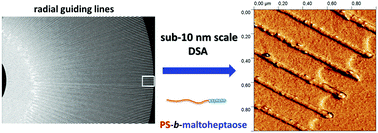Carbohydrate-based block copolymer systems: directed self-assembly for nanolithography applications
Abstract
Self-assembly of block copolymers (BCPs) provides an attractive nanolithography approach, which looks especially promising for fabrication of regular structures with characteristic sizes below 10 nm. Nevertheless, directed self-assembly (DSA) and pattern transfer for BCPs with such small features remain to be a challenge. Here we demonstrate DSA of the maltoheptaose-block-polystyrene (MH1,2k-b-PS4,5k) BCP system using graphoepitaxy. BCP thin films were self-organized by solvent vapor annealing in tetrahydrofuran (THF) and water into sub-10 nm scale cylinders of the maltoheptaose (MH) block oriented horizontally or perpendicularly to the surface in a polystyrene (PS) matrix. The guiding patterns for graphoepitaxy were made by the electron beam lithography (EBL) and lift-off process with the distance gradually varying between 0 and 200 nm. Atomic force microscopy (AFM) investigation of MH1,2k-b-PS4,5k BCP DSA patterns revealed good ordering of vertical and horizontal cylindrical MH arrays for DSA lines with 150–200 nm separation. Reactive ion etching (RIE) of MH1,2k and PS4,5k thin films in O2 and CF4 plasma showed up to 14 times higher etch rate of MH compared to PS. These results indicate that MH1,2k-b-PS4,5k is a promising BCP for nanolithographic applications below 10 nm.



 Please wait while we load your content...
Please wait while we load your content...